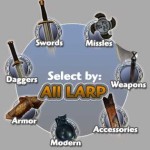This past week, I responded to Maury’s and Jenny’s outlines. Maury’s subject is one I’ve never examined closely, let alone through Network theory, so I was fascinated by her choice of subject. Maury skillfully pointed out how the vocabulary of hypertext theory and (especially) ANT gave her a way to begin exploring the way(s) LARPs “behave.” I found that her focus on the concept of “actors” to be especially productive, given how the subject matter lends itself to a singular understanding of that term. Her understanding of how hypertext theory defines her subject in terms of the actors brings into focus how a network theory application is suited to this area: “the reader/writer/player … no real distinction during the game; game only exists because the players have the agency to become writers.” Maury’s outline of how her application of hypertext theory and ANT reveals the potential exploratory nodes actually helped me better understand how I might apply what were rather difficult theory models for me.
The OoC selected by Jenny was also a compelling “non-academic” subject matter for which our theorization models can reveal new understanding. Jenny’s subject of the LaLeche League made me realize how social groups unrelated to traditional “work” organizations (as used by Spinuzzi or Johnson-Eilola or even Bazerman/Miller) can also be discussed in terms of genre and even agency/power. I was already familiar with the LLL from my days (long ago) of raising little ones, and so I already saw LLL as a form of cultural resistence in many ways. However, reading Jenny’s application of genre theory reminded me of Victorian era “advice” manuals — a genre I’ve studied in earlier graduate classes. As I wrote in one of my comments to her outline: “While the Victorian [advice manual] was one of social reinforcement, would you consider the LLL an act of resistence, given the American cultural trend away from breast feeding and women’s social status?” I was also reminded of Latour and even Spinuzzi while reading Jenny’s post, especially in terms of the “implied connection between the rhetorical practices of religious organizations and a mother’s support group – a cultural system of support and, at times, resistance” … layers of networks.
I am looking forward to reading both of their case studies once finished!



One Response to Outline Response: Case Study 2